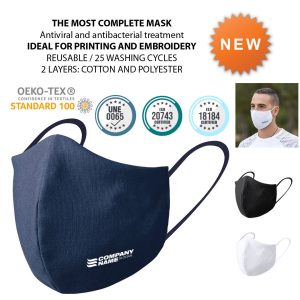COVID-19: How much protection do face masks offer?
COVID-19: How much protection do face masks offer?
Get answers to your questions about face masks, including how to use them properly. Can face masks help slow the spread of the coronavirus (SARS-CoV-2) that causes COVID-19? Yes, face masks combined with other preventive measures, such as frequent hand-washing and social distancing, help slow the spread of the virus.
So why weren't face masks recommended at the start of the pandemic? At that time, experts didn't know the extent to which people with COVID-19 could spread the virus before symptoms appeared. Nor was it known that some people have COVID-19but don't have any symptoms. Both groups can unknowingly spread the virus to others.
These discoveries led public health groups to do an about-face on face masks. The World Health Organization and the U.S. Centers for Disease Control and Prevention (CDC) now include face masks in their recommendations for slowing the spread of the virus. The CDC recommends cloth face masks for the public and not the surgical and N95 masks needed by health care providers.
How do the different types of masks work?
Surgical masks
Also called a medical mask, a surgical mask is a loose-fitting disposable mask that protects the wearer's nose and mouth from contact with droplets, splashes and sprays that may contain germs. A surgical mask also filters out large particles in the air. Surgical masks may protect others by reducing exposure to the saliva and respiratory secretions of the mask wearer.
At this time, the U.S. Food and Drug Administration has not approved any type of surgical mask specifically for protection against the coronavirus, but these masks may provide some protection when N95 masks are not available.
N95 masks
Actually a type of respirator, an N95 mask offers more protection than a surgical mask does because it can filter out both large and small particles when the wearer inhales. As the name indicates, the mask is designed to block 95% of very small particles. Some N95 masks have valves that make them easier to breathe through. With this type of mask, unfiltered air is released when the wearer exhales.
Health care providers must be trained and pass a fit test to confirm a proper seal before using an N95 respirator in the workplace. Like surgical masks, N95 masks are intended to be disposable. However, researchers are testing ways to disinfect N95 masks so they can be reused.
Some N95 masks, and even some cloth masks, have one-way valves that make them easier to breathe through. But because the valve releases unfiltered air when the wearer breathes out, this type of mask doesn't prevent the wearer from spreading the virus. For this reason, some places have banned them.
Cloth masks
A cloth mask is intended to trap droplets that are released when the wearer talks, coughs or sneezes. Asking everyone to wear cloth masks can help reduce the spread of the virus by people who have COVID-19 but don't realize it.
Cloth face coverings are most likely to reduce the spread of the COVID-19 virus when they are widely used by people in public settings. And countries that required face masks, testing, isolation and social distancing early in the pandemic have successfully slowed the spread of the virus.
While surgical and N95 masks may be in short supply and should be reserved for health care providers, cloth face coverings and masks are easy to find or make, and can be washed and reused.
Masks can be made from common materials, such as sheets made of tightly woven cotton. Instructions are easy to find online. Cloth masks should include multiple layers of fabric. The CDCwebsite even includes directions for no-sew masks made from bandannas and T-shirts.
How to wear a cloth face mask
The CDC recommends that you wear a cloth face mask when you're around people who don't live with you and in public settings when social distancing is difficult.
Here are a few pointers for putting on and taking off a cloth mask:
- Wash or sanitize your hands before and after putting on and taking off your mask.
- Place your mask over your mouth and nose.
- Tie it behind your head or use ear loops and make sure it's snug.
- Don't touch your mask while wearing it.
- If you accidentally touch your mask, wash or sanitize your hands.
- If your mask becomes wet or dirty, switch to a clean one. Put the used mask in a sealable bag until you can wash it.
- Remove the mask by untying it or lifting off the ear loops without touching the front of the mask or your face.
- Wash your hands immediately after removing your mask.
- Regularly wash your mask with soap and water by hand or in the washing machine. It's fine to launder it with other clothes.
And, here are a few face mask precautions:
- Don't put masks on anyone who has trouble breathing, or is unconscious or otherwise unable to remove the mask without help.
- Don't put masks on children under 2 years of age.
- Don't use face masks as a substitute for social distancing.
Tips for adjusting to a face mask
It can be challenging to get used to wearing a face mask. Here are some tips for making the transition:
- Start slow. Wear your mask at home for a short time, such as while watching television. Then wear it during a short walk. Slowly increase the time until you feel more comfortable.
- Find your fit. If your mask isn't comfortable or is too difficult to breathe through, consider other options. Masks come in a variety of styles and sizes.
- Tie one on. Instead of a face mask, try a scarf or bandanna to cover your nose and mouth.
If these tips don't help or you have concerns about wearing a mask, talk with your doctor about how to protect yourself and others during the pandemic.
Reference from the Mayo Clinic

